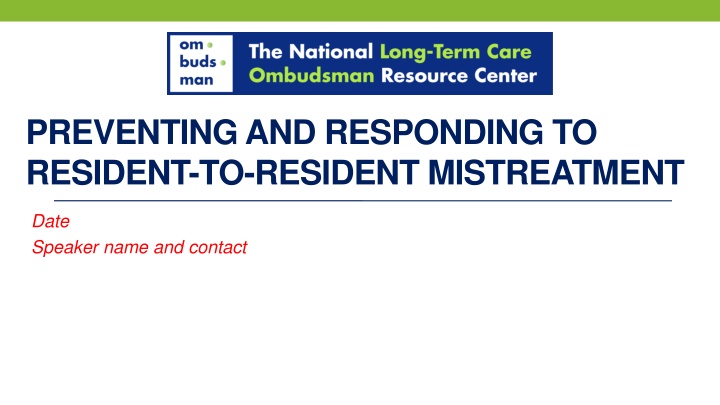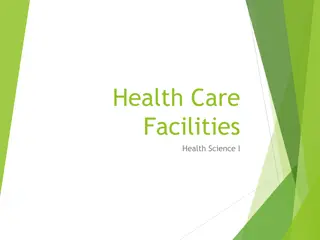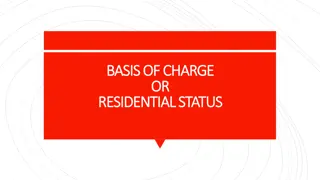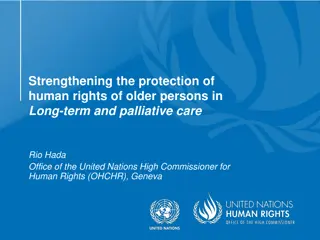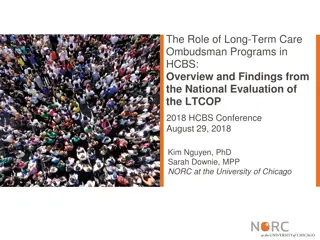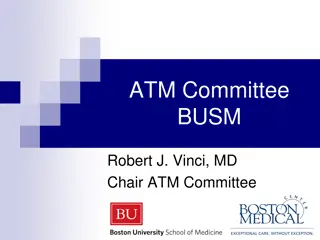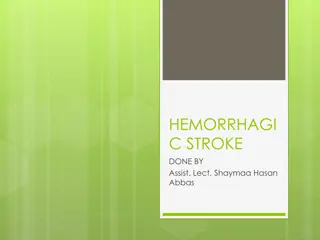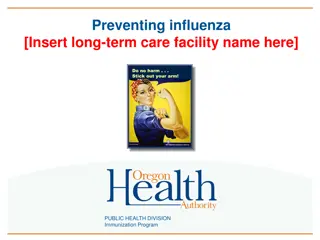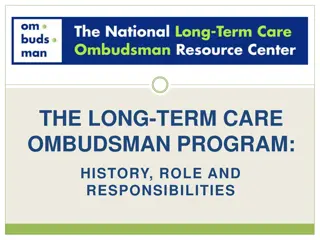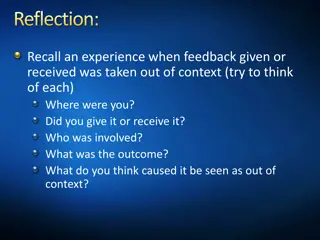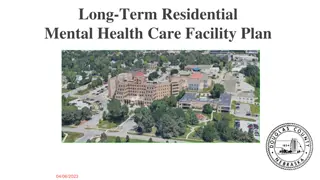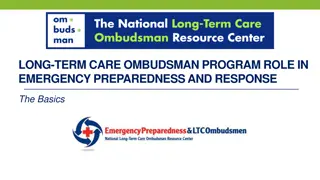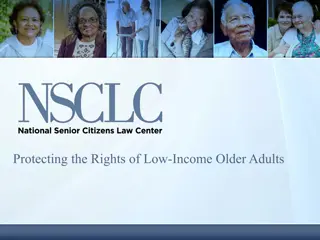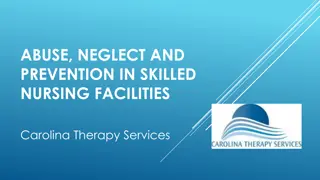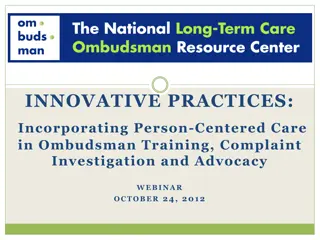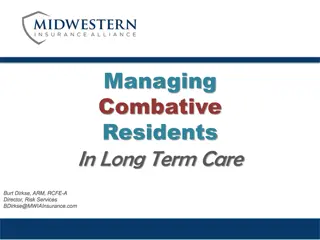Preventing and Responding to Resident-to-Resident Mistreatment in Long-Term Care Facilities
Resident-to-resident mistreatment (RRM) in long-term care settings can cause physical and psychological distress to residents. This presentation covers the definition of RRM, practical solutions for prevention, the importance of individualized care, and reporting procedures. Examples of RRM include physical, verbal, and sexual abuse. The impact of RRM includes loneliness, staff injuries, depression, anxiety, functional decline, and decreased quality of life. It is crucial to recognize and address incidents of RRM to ensure the well-being of residents and staff.
Download Presentation

Please find below an Image/Link to download the presentation.
The content on the website is provided AS IS for your information and personal use only. It may not be sold, licensed, or shared on other websites without obtaining consent from the author.If you encounter any issues during the download, it is possible that the publisher has removed the file from their server.
You are allowed to download the files provided on this website for personal or commercial use, subject to the condition that they are used lawfully. All files are the property of their respective owners.
The content on the website is provided AS IS for your information and personal use only. It may not be sold, licensed, or shared on other websites without obtaining consent from the author.
E N D
Presentation Transcript
PREVENTING AND RESPONDING TO RESIDENT-TO-RESIDENT MISTREATMENT Date Speaker name and contact
Learning Objectives Define resident-to-resident mistreatment (RRM), Provide practical solutions to prevent incidents of RRM, Understand the importance of individualized, resident- centered care, and Know how to report incidents of RRM.
What is Resident-to-Resident Mistreatment (RRM)? Negative physical, sexual, or verbal interactions between long-term care residents that in a community setting would likely be construed as unwelcome and have high potential to cause physical or psychological distress in the recipient. Source: A staff intervention targeting resident-to-resident elder mistreatment (R-REM) in long-term care increased staff knowledge, recognition and reporting: Results from a cluster randomized trial. Jeanne A. Teresi, Mildred Ramirez, Julie Ellis, Stephanie Silver, Gabriel Boratgis, Jian Kong, Joseph P. Eimicke, Karl Pillemer, and Mark S. Lachs. International Journal of Nursing Studies (2013), 644 656. https://www.ncbi.nlm.nih.gov/pmc/articles/PMC3677710/
Examples of Resident-to-Resident Mistreatment (RRM) Incidents of resident-to-resident mistreatment include physical, verbal, and sexual abuse and are likely to cause emotional and/or physical harm. Not all incidents of RRM are considered abuse, meaning the resident did not willfully intend to harm the other resident. Examples of RRM include: Hitting, kicking, biting Screaming Cursing Pushing Throwing items Invading privacy and personal space Verbal threats and harassment Roommate conflicts Unwanted sexual behavior Destroying personal property
Have you witnessed, or heard about, an incident of resident-to-resident mistreatment? If so, what did you do?
Impact of Resident-to-Resident Mistreatment On Residents Loneliness On Staff Injuries Depression Discontent with the job (perhaps resulting in staff leaving) Anxiety Anxiety about how to handle an active situation Functional decline Injuries such as falls, fractures, lacerations, abrasions, and cuts Negative attitude toward the aggressor Decreased quality of life (Ellis et al., 2014, Trompetter et al., 2011)
Facility Requirements Regardless of the type of long-term care facility, all residents have the right to live in a safe environment that supports each resident s individuality and ensures they are treated with respect and dignity. All states require that residents be protected from abuse, neglect, and exploitation.
Facility Requirements Assisted Living There are no federal regulations governing assisted living and similar facilities and requirements are different in each state. Assisted living and similar facilities that have a Medicaid contract have specific requirements as a Medicaid provider, including developing a person-centered service plan. Plans describe the preferences and interests that make up a desired life and the supports (paid and unpaid) needed to achieve it. Plans are directed by the person along with independent facilitation support as needed.
Federal Nursing Home Requirements 483.10(a)(1) A facility must treat each resident with respect and dignity and care for each resident in a manner and in an environment that promotes maintenance or enhancement of his or her quality of life, recognizing each resident s individuality. The facility must protect and promote the rights of the resident. (F550) 483.12 Freedom from Abuse, Neglect, and Exploitation The resident has the right to be free from abuse, neglect, misappropriation of resident property, and exploitation (F600) 483.21(b) Comprehensive Care Plans 483.21(b)(1) The facility must develop and implement a comprehensive person-centered care plan for each resident (F656)
Person-Centered Care Federal Nursing Home Requirements Person-centered care means the facility focuses on the resident as the center of control and supports each resident in making his or her own choices. Person-centered care includes making an effort to understand what each resident is communicating, verbally and nonverbally, identifying what is important to each resident with regard to daily routines and preferred activities, and having an understanding of the resident s life before coming to reside in the nursing home. Staff should routinely read the care plans. The care plans should include interventions (if necessary). 483.10(c)(2) The right to participate in the development and implementation of his or her person-centered plan of care (F553) Baseline Care Plans (F655) 483.21(b) Comprehensive Care Plans (F656)
Nursing Home State Operations Manual - Appendix PP Freedom from Abuse, Neglect, and Exploitation (F600) A resident to resident altercation should be reviewed as a potential situation of abuse. This F-tag also addresses sexual abuse between residents Facilities should complete a resident assessment and provide care planning interventions. Free of Accident Hazards/Supervision/Devices (F689) Determine if the facility ensured that the resident environment remains as free from accident hazards as is possible and each resident receives adequate supervision to prevent accidents related to resident-to-resident altercations where the resident s action is not willful.
As mentioned in the last slide, the SOM states that redirection alone is not a sufficiently protective response. What other interventions can you suggest?
Risk Factors Resident Characteristics Residents with significant cognitive impairments. Residents with behavioral symptoms related to their cognitive impairment (e.g., yelling, entering others rooms). Residents with a history of aggressive behavior and/or negative interactions with others. Information on slides 12 15 adapted from: Division of Geriatrics and Palliative Care, Weill Cornell Medical College, Cornell University and Research Division, Hebrew Home at Riverdale. Documentation of Resident to Resident Elder Mistreatment in Residential Care Facilities. Mark Lachs, Jeanne A. Teresi, Mildred Ramirez, Karl Pillemer, Joy Soloman, and Kimberly van Haitsma (March 28, 2014) and Eilon Caspi, Deaths as a Result of Resident-to-Resident Altercations in Dementia in Long-term Care Homes: A Needs for Research, Policy, and Intervention, Editorial, JAMDA (2016).
Risk Factors and Recommendations Resident Characteristics Risk Factors Recommendations Identify residents with risk factors for RRM, care plan to meet their needs, and monitor. Residents with significant cognitive impairments. Identify root causes of behavioral symptoms and address them (e.g., pain, boredom, fear, sadness, hunger, changes in care needs). Is this a new behavior? If so, conduct a full assessment. Residents with behavioral symptoms related to their cognitive impairment (e.g., yelling, entering other s rooms). Residents with a history of aggressive behavior and/or negative interactions with others. Develop comprehensive care plans. Provide individualized, person-centered care.
Risk Factors Facility Characteristics (environmental and care) Excessive noise. Crowded common areas. Inadequate number of staff. Lack of staff training about individualized care in order to support residents needs, capabilities, and rights. Lack of meaningful activities and engagement.
Risk Factors and Recommendations Facility Characteristics (environmental and care) Risk Factors Recommendations Clear clutter, reduce noise and overcrowding. Excessive noise. Provide areas for supervised, unrestricted, safe movement. Crowded common areas. Promote meaningful activities. Inadequate number of staff. Identify and change environmental influences on behavior. Lack of staff training about individualized care in order to support residents needs, capabilities, and rights. Implement consistent staffing assignments. Provide training regarding supporting needs of individuals with limited mental capacity and/or behavioral health needs. Lack of meaningful activities and engagement. Recommendations from RRA research and CMS SOM Appendix PP. F323. Links to additional information, such as Culture Change and Resident-Centered Care is available in the Resources section. http://ltcombudsman.org/uploads/files/library/som107ap_pp_guidelines_ltcf.pdf Ensure adequate staffing.
Investigating and Reporting Incidents Facility staff must report all incidents to their supervisor and/or facility administrator per facility policy and licensure requirements. Every incident of resident-to-resident mistreatment should be investigated, and an assessment of each resident must be made to determine: the impact on the residents involved, care plan interventions to support each resident, how future incidents can be prevented. Facilities must follow federal and/or state requirements regarding reporting incidents, such as reporting injuries of unknown source; potential abuse, neglect, or exploitation. Nursing homes receiving Medicaid/Medicare must report all suspected crime to local law enforcement and the state survey agency.
Key Resources NORC Issue Page Resident-to-Resident Mistreatment http://ltcombudsman.org/issues/abuse-neglect-and-exploitation-in-long-term-care- facilities#resident-to-resident Resident-to-Resident Elder Mistreatment (RREM) A Training and Education Guide. Available for purchase from Research Division of The Hebrew Home At Riverdale. http://research- hhar.org/ A staff intervention targeting resident-to-resident elder mistreatment (R-REM) in long-term care increased staff knowledge, recognition and reporting. https://www.ncbi.nlm.nih.gov/pmc/articles/PMC3677710/ Writing I Care Plans http://www.vhca.net/wp-content/uploads/sites/7/2014/10/VTHCA-2014-I- Format-Care-Plan-Session.pdf
What is Resident Mistreatment? Consumer Brochure and Large Font Fact Sheet Overview of Residents Rights Defines Resident-to- Resident Mistreatment Explains how to seek help http://theconsumervoice.org/uploads/files /issues/rrm-brochure-508-compliant.pdf (brochure) http://theconsumervoice.org/uploads/files /issues/rrm-factsheet-large-font-508- compliant.pdf (large font fact sheet)
Consumer Voice Resources www.theconsumervoice.org Fact Sheets Assessment and Care Planning Basics of Individualized Care Residents Rights Guide to Choosing a Nursing Home Abuse and Neglect Emergency Preparedness Restraint Free Care Guides Piecing Together Quality Long- Term Care: A Consumer s Guide to Choices and Advocacy Nursing Homes: Getting Good Care There Resident and Family Council information
Key Takeaways Residents have the right to live in a safe environment that supports each resident s individuality and ensures they are treated with respect and dignity. Resident-to-resident mistreatment is a serious issue that has a significant negative impact on all residents involved, but incidents are often not reported and investigated. Behavior is often a form of communication and in order to provide appropriate, resident-centered care staff need to identify the root cause of the behavior and understand what the resident is trying to communicate. Providing individualized, resident-centered care and having an adequate number of well-trained staff are critical to ensuring all residents receive the care they need and are protected from mistreatment.
Three Barriers to Change Acceptance Ignorance Inaction
Connect with us: www.ltcombudsman.org ombudcenter@theconsumervoice.org cid:image003.jpg@01CFB310.A36779F0 The National LTC Ombudsman Resource Center cid:image004.jpg@01CFB310.A36779F0 @LTCombudcenter Get our app! Search for "LTC Ombudsman Resource Center" in the Apple Store or Google Play This project was supported, in part, by grant number 90OMRC0002-01-00, from the U.S. Administration for Community Living, Department of Health and Human Services, Washington, D.C. 20201. Grantees undertaking projects under government sponsorship are encouraged to express freely their findings and conclusions. Points of view or opinions do not, therefore, necessarily represent official Administration for Community Living policy. Updated May 2022
